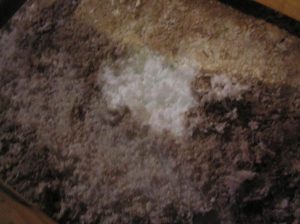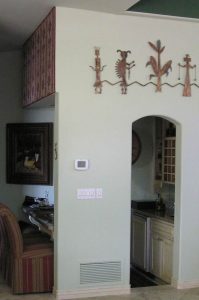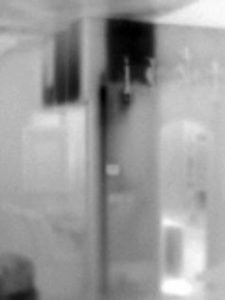- Prescott & Tucson (928) 445-3828
- Phoenix Metro (623) 939-3329
- Prescott & Tucson (928) 445-3828
- Phoenix Metro (623) 939-3329

The customer took her index finger and ran it across her grand piano in her living room and asked me if I could see the dust streak. The dust was very apparent and the question was asked to establish a point. It was clearly implied, “dust is my problem and if you undertake this job to get rid of it, I will bench mark the success of your work by evaluating how much dust settles on my grand piano the day after I clean it.”
The customer proceeded to tell me that the excessive amount of dust in her house was disgusting. Her husband simply wanted the problem solved so the constant complaining would stop. She skeptically asked, “can you solve this problem?” I told her that I would let her know after Advantage Home Performance’s audit team completed their evaluation.
The first thing I had to determine was if the problem was real or imagined. I began by inspecting dust levels on tops of cabinets, pot shelves and other places that cleaners never dusted to determine if the problem was legitimate. Our auditor also took measurements with our laser particle counter. Our visual inspection and measurements indicated that there was a significant amount of dust in the air and on surfaces.
The next step was to test the home. Advantage Home Performance’s audit team performed a variety of tests including blower door and duct blaster tests, as well as testing room pressures and an infrared scan. The high duct leakage and room pressures indicated that there was a great deal of air communication between the house and the attic. I suspected the dust was coming from the attic and getting into the house due to a variety of holes in the building envelope and pressures driving the air flow.
An inspection of the attic convinced us that the problem was real and that we could really help this homeowner. The blown white fiberglass in the attic directly under the attic vents almost looked like cellulose due to the heavy layer of dust on top of this existing insulation. The amount of dust coming through the attic vents was significant. This dust was finding its way into the home every day.

White blown fiberglass insulation covered with a heavy level of dust In the attic.
The dust found its way into the house via duct leakage and pressure imbalances due to door closure. The air handlers were running 24/7 so the state-of-the-art electronic filters could do their job, but running the air handlers only made the problem worse. Dust was being sucked through every recessed electrical can light in the main body of the house when bedroom doors were shut. Return leaks were sucking dusty air into the house.
If you examine the two photographs below carefully you can actually see the attic air being sucked down an interior wall and into the return. These are two photographs of the same wall in the house. Notice the return grille on the bottom left. The return is actually drawing air from the attic and this phenomena can be seen in the infrared image on the right hand side shows a dark streak going down the interior wall and into the return. Since this photo is taken the winter that dark streak is cool air being sucked into the house via the attic. The dust in the attic completely overwhelmed the state of the air filters that were supposed to solve this problem.

Interior wall with
framed return cavity

Infrared image of cold attic
air being sucked into return
I proposed a package of improvements that included insulation removal, elimination of the attic vents, cathedralized half pound foam insulation coupled with duct sealing and fresh air ventilation with HEPA filtration. The homeowner accepted our quote because it provided the greatest likelihood for success.
By removing the attic insulation we effectively got rid of all the dusty fibrous insulation in the attic. Insulation removal is also a code requirement. The 2009 IRC requires that the insulation and pressure envelope are to be aligned. Another big benefit of insulation removal is that the chances of the air barrier being properly defined goes up dramatically.
Source control is the first step in dealing with dust and indoor air quality problems. By covering up the attic vents with sheet metal prior to spraying the foam we in effect eliminated the entry point of most of the dust that is getting into the home. The half pound foam is classified as an air barrier, as well as insulation, so we completely sealed off the attic from the outdoors.
I also knew that by bringing the duct work inside the thermal pressure envelope, not only were we going to dramatically reduce the dust levels in the home, but we were going to see large energy savings. According to Manual J, the duct load can be 25% to 40% of the sensible load. Insulating at the bottom chord of a truss and leaving duct work in an extremely hot attic will eventually be seen as an obsolete way of building and insulating a home. Foam is the future of insulating and retrofitting homes in the desert when there is an air distribution system in the attic.
The post-repair blower door testing proved that we reduced the measured air leakage of the structure dramatically; we had the customer install a Venmar HEPA 4100 because the house was below the minimum ventilation requirement. Not only did we bring in fresh air to meet BPI and ASHRAE Standards, but we filtered the outdoor air through a HEPA filter.
Foam attic with Venmar HEPA filtration unit
Venmar fresh air ventilation unit with HEPA filtration with foam insulation installed on the underside of the roof deck
Advantage Home Performance’s work passed the piano test. Our customer was very satisfied with our dust mitigation work. Although there will always be dust generated by the occupants, their dogs, clothes, etc. the dust levels were dramatically reduced. The customer also noted that their utility bill dropped significantly and the humidity level was much more comfortable. Although the ticket price for the retrofit foam was high, the foam retrofit approach proved to be very effective at solving this customer’s dust problem.